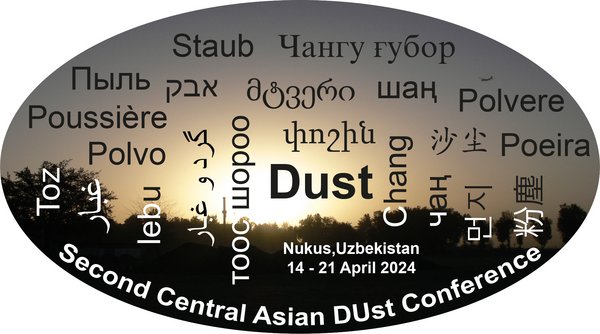Second Central Asian DUst Conference (CADUC-2)
15 - 22 April 2024
at the Karakalpak State University named after Berdakh (KSU)
Ch. Abdirov St. 1, Nukus, Republic of Karakalpakstan, Uzbekistan, 230112
Dust - Chang
Dust in the atmosphere of Central Asia is a regional, continental, and intercontinental phenomenon and affects the people’s life and economies. Joint efforts are necessary to assess the dust related problems and to improve the people’s life.
The conference worked as a platform for scientific exchange about dust research between meteorology, physics, chemistry, biology and geography. The conference supported the communication of basics and new findings to senior scientists, young scientists, administrative staff, and policy makers.
Goals of the Conference
- Promote discussions between scientists who study dust in the atmosphere and at Earth's surface, especially in Central Asia
- Summarize textbook knowledge of atmospheric dust and new insights into dust, identify differences between Central Asian dust and Saharan dust and dust from other deserts, and derive conclusions
- Characterization of dust in the atmosphere and on the earth's surface at source areas, transport, deposition areas, and dust impacts on humans, plants, economies, etc.
- Description of possible vulnerabilities and actions: to avoid dust events, as well as precautions when dust events occur (warning systems of/for countries)
- Description of possible predictions and scenarios (diseases, plant growth, well-being, etc), if nothing is done against dust distribution
- Special rounds to discuss policy recommendations resulting from the scientific findings
Topics of the Conference
The conference had the following sessions:
1 Atmospheric dust at source regions
2 Dust properties at transport
3 Atmospheric dust at sink regions
4 Aral Sea region as dust source and dust sink
5 Impacts of atmospheric dust
6 Dust early warning systems
7 Success stories in controlling sand and dust storm (SDS) hotspots
Policy recommendations
- Central Asia is particularly vulnerable to dust storms. There is a critical gap in understanding and mitigating the impacts of dust storms in the region. Until now, there is no WMO regional Sand and Dust Storm Warning Advisory and Assessment System (SDS-WAS) center for Central Asia. The WMO regional centers in Barcelona, Beijing and Jeddah only partly cover Central Asian dust emissions. A new regional dust forecast center for the region would be highly desirable.
- Reinforcing science cooperation between countries because dust is an international problem (transboundary, regional, continental, intercontinental). Especially, it is recommended to strengthen cooperation between research institutes and WMO regional centers specialized in sand and dust storms (SDS).
- In the Aral Sea region, first of all, practical field studies should be carried out to assess the environmental impact of dust, salt, and sand emissions from the dry bottom of the Aral Sea. In particular, it is necessary to study the movement of dust, salt, and sand in this region and beyond. Investigations should address the natural geoecological processes in the region, the phenomenon of desertification, the spread of soil, vegetation, salt and sand, as well as climate impacts in regions far away from the Aralkum.
- Since satellite monitoring and retrievals are limited throughout the year in Central Asia or more specifically in the Aralkum region, it is highly encouraged to enhance the ground-based monitoring capabilities, e.g., from a sun photometer or even a vertical profiling instrument (lidar). Ideally the measured data should be made public via some of the already established platforms (e.g., AERONET).
- Adequate remote-sensing monitoring systems should be installed. These should include a multi-method approach: ground-based observations, satellites and models. New reanalysis products are essential for the region of Central Asia. In order to correctly assess the impact of dust from Central Asia on air quality in downwind areas, it is necessary to monitor where and what type of aerosols (e.g., mineral dust, urban pollution, wildfire smoke) are being transported. This is a global effort for which international collaboration is needed.
- There is good progress in the description of seasonal patterns based on satellite observations and modelling, but single events are difficult to recognize in advance (e.g. the event of November 4-14, 2021). It is necessary to develop a dust event warning system for the local population enhanced by ground-based observations.
- Dust storms can substantially reduce the yields of crops, trees, pastures and livestock. Policymakers should take action to mitigate these adverse impacts on agriculture, an important economic sector in the countries of Central Asia. Specific recommendations to reduce the dust emissions and soil loss from agricultural land in dryland areas:
- Agricultural systems should prevent the destruction of dry aggregates during seedbed preparation by considering soil moisture during agricultural practices, such as the timing of sowing, the temporal variations during the day, and the variability in tillage depth.
- Dirt roads and agricultural pathways are serious sources of dust emissions in semi-arid croplands, which can be prevented by the construction and maintenance of paved roads.
- Use the research results to identify key dust-source regions and encourage the national stakeholders to install measures to reduce dust emissions especially in these hot spot regions. An encouraging example is the bilateral cooperation between Kuwait and Iraq in mitigating dust hot spot regions in the Tigris-Euphrates floodplains.
- We recognize that different aerosol components impact health differently. One specific example is aerosol metals because they negatively impact public health. Hence, it is essential to measure their concentrations (along with other constituents by chemical analysis) and to comprehensively characterize aerosol composition as they influence human, plant, and ecological health. Local mitigation strategies on reducing winter emissions from residential heating fuels including coal combustion should be considered to reduce associated health risks.
- A global effort is needed to help dust-affected regions mitigate the losses and damage caused by dust. Initiating this effort should be a central feature of the United Nations Decade on Combating Sand and Dust Storms (2025-2034).

